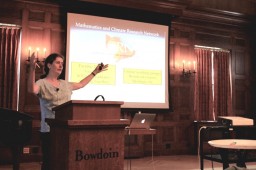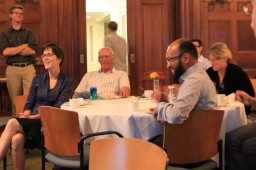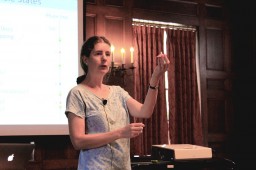Sabbatical Seminars: Zeeman on Tipping Points and Environmental Resilience






In each weekly lunch seminar, faculty from across Bowdoin’s curriculum gather for a presentation by one of their colleagues, who is typically returning from a sabbatical devoted to research or an artistic project.
Environmental sustainability depends on the integration of a whole array of disciplines, Zeeman said – policy, economics, environmental science, and more – and mathematicians have the capability of bridging all of them. “But that requires an incredible amount of interdisciplinary courage,” she said. “We’ve got to train our students to do this, and give them that courage.”
Leading by example, Zeeman spent part of her sabbatical in England last year speaking with stakeholders. “The two words I have been finding most interesting were exactly the two words that all of the stakeholders wanted to talk about: quantifying resilience” – resilience being a system’s ability to absorb disturbances without losing its basic structure and function. “Everybody’s interested in resilience, and everyone wants to quantify it.”
Take fisheries, for example: when a fish population declines because of overfishing, it may drop to a size that’s within its range of resilience – and then rebound, assuming the fishing pressure lets up. But if fish numbers drop below a specific tipping point, even if fishing halts entirely, the population will continue to decline until it reaches another stable size. That might mean stabilizing at very low numbers, as cod in the Gulf of Maine appear to have done, or going extinct.
We can predict those dynamics by collecting data and devising mathematical models, as Zeeman illustrated with simple graphs. By tracking changes in the system’s resilience, we have a chance at identifying tipping points – and potentially irreversible population declines – before they happen. That’s why “decision makers should be looking at how a proposed policy influences resilience,” Zeeman said. “We need to help decision makers decide how to spend the money in sensible ways.”
Zeeman is co-director (with art history professor Pamela Fletcher) of Bowdoin’s Digital and Computational Studies Initiative as well as co-director of the national organization the Mathematics and Climate Research Network. She lectured on tipping points and the environment last year as part of the Mathematical Association of America Distinguished Lecture Series (watch the video).



